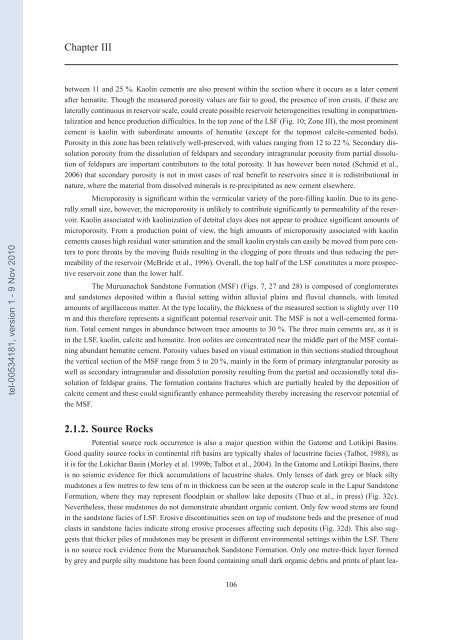Etude stratigraphique, pétrographique et diagénétique des grès d ...
Etude stratigraphique, pétrographique et diagénétique des grès d ...
Etude stratigraphique, pétrographique et diagénétique des grès d ...
Create successful ePaper yourself
Turn your PDF publications into a flip-book with our unique Google optimized e-Paper software.
tel-00534181, version 1 - 9 Nov 2010<br />
Chapter III<br />
b<strong>et</strong>ween 11 and 25 %. Kaolin cements are also present within the section where it occurs as a later cement<br />
after hematite. Though the measured porosity values are fair to good, the presence of iron crusts, if these are<br />
laterally continuous in reservoir scale, could create possible reservoir h<strong>et</strong>erogeneities resulting in compartmentalization<br />
and hence production difficulties. In the top zone of the LSF (Fig. 10; Zone III), the most prominent<br />
cement is kaolin with subordinate amounts of hematite (except for the topmost calcite-cemented beds).<br />
Porosity in this zone has been relatively well-preserved, with values ranging from 12 to 22 %. Secondary dissolution<br />
porosity from the dissolution of feldspars and secondary intragranular porosity from partial dissolution<br />
of feldspars are important contributors to the total porosity. It has however been noted (Schmid <strong>et</strong> al.,<br />
2006) that secondary porosity is not in most cases of real benefit to reservoirs since it is redistributional in<br />
nature, where the material from dissolved minerals is re-precipitated as new cement elsewhere.<br />
Microporosity is significant within the vermicular vari<strong>et</strong>y of the pore-filling kaolin. Due to its generally<br />
small size, however, the microporosity is unlikely to contribute significantly to permeability of the reservoir.<br />
Kaolin associated with kaolinization of d<strong>et</strong>rital clays does not appear to produce significant amounts of<br />
microporosity. From a production point of view, the high amounts of microporosity associated with kaolin<br />
cements causes high residual water saturation and the small kaolin crystals can easily be moved from pore centers<br />
to pore throats by the moving fluids resulting in the clogging of pore throats and thus reducing the permeability<br />
of the reservoir (McBride <strong>et</strong> al., 1996). Overall, the top half of the LSF constitutes a more prospective<br />
reservoir zone than the lower half.<br />
The Muruanachok Sandstone Formation (MSF) (Figs. 7, 27 and 28) is composed of conglomerates<br />
and sandstones deposited within a fluvial s<strong>et</strong>ting within alluvial plains and fluvial channels, with limited<br />
amounts of argillaceous matter. At the type locality, the thickness of the measured section is slightly over 110<br />
m and this therefore represents a significant potential reservoir unit. The MSF is not a well-cemented formation.<br />
Total cement ranges in abundance b<strong>et</strong>ween trace amounts to 30 %. The three main cements are, as it is<br />
in the LSF, kaolin, calcite and hematite. Iron oolites are concentrated near the middle part of the MSF containing<br />
abundant hematite cement. Porosity values based on visual estimation in thin sections studied throughout<br />
the vertical section of the MSF range from 5 to 20 %, mainly in the form of primary intergranular porosity as<br />
well as secondary intragranular and dissolution porosity resulting from the partial and occasionally total dissolution<br />
of feldspar grains. The formation contains fractures which are partially healed by the deposition of<br />
calcite cement and these could significantly enhance permeability thereby increasing the reservoir potential of<br />
the MSF.<br />
2.1.2. Source Rocks<br />
Potential source rock occurrence is also a major question within the Gatome and Lotikipi Basins.<br />
Good quality source rocks in continental rift basins are typically shales of lacustrine facies (Talbot, 1988), as<br />
it is for the Lokichar Basin (Morley <strong>et</strong> al. 1999b; Talbot <strong>et</strong> al., 2004). In the Gatome and Lotikipi Basins, there<br />
is no seismic evidence for thick accumulations of lacustrine shales. Only lenses of dark grey or black silty<br />
mudstones a few m<strong>et</strong>res to few tens of m in thickness can be seen at the outcrop scale in the Lapur Sandstone<br />
Formation, where they may represent floodplain or shallow lake deposits (Thuo <strong>et</strong> al., in press) (Fig. 32c).<br />
Nevertheless, these mudstones do not demonstrate abundant organic content. Only few wood stems are found<br />
in the sandstone facies of LSF. Erosive discontinuities seen on top of mudstone beds and the presence of mud<br />
clasts in sandstone facies indicate strong erosive processes affecting such deposits (Fig. 32d). This also suggests<br />
that thicker piles of mudstones may be present in different environmental s<strong>et</strong>tings within the LSF. There<br />
is no source rock evidence from the Muruanachok Sandstone Formation. Only one m<strong>et</strong>re-thick layer formed<br />
by grey and purple silty mudstone has been found containing small dark organic debris and prints of plant lea-<br />
106

















